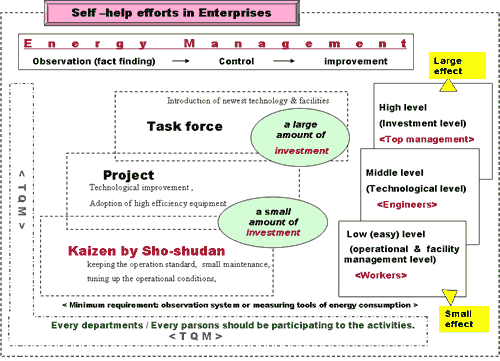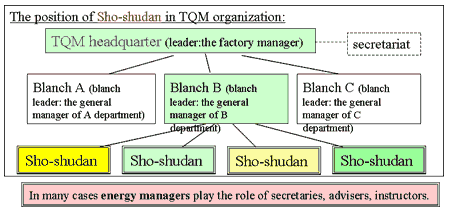|
Step
1
Enhancement of management, Improvement
of operation
|
Step
2
Additional installation or improvement
of equipment
|
Step
3
Change in process, Use of high-efficiency
equipment
|
Rationalization
of fuel combustion |
- Improvement of air
ratio (stabilization of load factors
by means of selection of burners, cleaning
of burners, furnace pressure control,
prevention of air entry, etc.)
|
- Combustion control through exhaust
gas analysis
- Installation of combustion control
devices
- Adjustment of gas calorie
|
- Low NOx burners
- Fluidized bed combustion
- Fuel change
|
Rationalization
of heating/cooling and heat transfer |
- Optimization of seam pressure
- Cleaning the heating surface
- Improvement of heat patterns
- Improvement of methods of charging
materials to be heated
|
- Extension of the preheating zone
of industrial furnaces, Reduction
of heat capacity
- Improvement of control accuracy
- Additional installation of heat
exchangers, Use of multiple effect
- Increasing the stages for the
distillation tower, Changing filling
materials
|
Omission of processes,
Utilization of sensible heat in the
preceding process (hot strip charge),
Re-compression of steam, Improvement
of catalyst (PP, exhaust gas treatment),
Use of film, Changing the constituents
(low-temperature paints, materials that
do not require heat treatment), Heating
by infrared rays, Changing materials
(use of recycled paper and water sediment),
and jet heating |
Prevention
of heat loss through radiation/heat
transfer |
- Optimization of the volume of
boiler blow water
- Reducing the radiation surface
area and standby time
- Prevention of steam leaking portions,
etc
- Reinforcement of heat insulation, Reduction of opening areas
|
- Continuous blow equipment
- Selection of steam traps Removal
of unnecessary piping
- Spraying rock wool
|
Reducing time by use
of larger current for electric furnaces |
Recovery
and reuse of waste energy |
Prevention of waste
energy leaks |
- Closed recovery of condensate
- Anti-corrosive heat exchangers
- Heat pipe, Heat pumps
|
- Power generation through recovery
of low to medium temperature waste
heat, Power generation through recovery
of waste pressure, Recovery of waste
heat from solids (slag, coke, and
sintered ores)
- Energy supply to parties outside
the factory (regional heating/cooling)
|
Rationalization
of conversion of heat into motive
power, etc. |
- Optimization of extraction, Back
steam pressure
- Improvement of boiler turbine
load distribution
- Variable pressure operation
|
- Higher efficiency of turbine
blades and nozzles
- Rationalization of steam
ejectors
- Recovery of motive power from
vacuum steam
|
- Higher temperatures/pressure of
steam
- Combined heat and power supply
(co-generation, fuel cells)
- Combined cycle power generation, Improvement of engine efficiency
|



